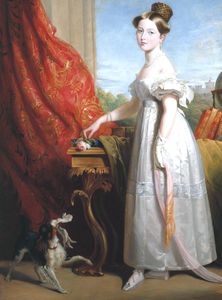Breed History

(Image: Future King Charles II, circa 1635)
Today’s Cavalier King Charles Spaniel is descended from the small Toy Spaniels depicted in so many sixteenth, seventeenth, and eighteenth century paintings. These paintings show small spaniels with flat heads, high set ears, almond eyes, and rather pointed noses. During Tudor times, Toy Spaniels were quite common as ladies' pets, but it was under the Stuarts that they were given the royal title of King Charles Spaniels. King Charles II was seldom seen without 2 or 3 spaniels at his heels. He was so fond of his little dogs, that he wrote a decree that the King Charles Spaniel should be accepted in any public place, even in the Houses of Parliament. (This decree is still in existence today in England.) As time went by, and with the coming of the Dutch Court, Toy Spaniels went out of fashion and were replaced in popularity by the Pug. One exception was the strain of red and white Toy Spaniels that was bred at Blenheim Palace by various Dukes of Marlborough.

(Image: Future Queen Victoria with her dog, Dash - 1833)
Young Queen Victoria had beloved tri-color spaniel called "Dash". Dash features prominently in early episodes of the excellent PBS series "Victoria".
Long ago, there were no dog shows and no recognized breed standard, so both type and size varied. By the mid-nineteenth century, England took up dog breeding and dog showing seriously. Many breeds were developed and others altered. This brought a new fashion to the Toy Spaniel - dogs with the completely flat face, undershot jaw, domed skull with long, low set ears and large, round frontal eyes of the modern King Charles Spaniel (also called "Charlies" and known in the United States today as the English Toy Spaniel). As a result of this new fashion, the King Charles Spaniel, of the type seen in the early paintings, became almost extinct.
In 1926, the Kennel Club was persuaded to allow a rich American to offer prizes for the best bitch or dogs of the Blenheim variety as seen in King Charles II's reign, after he had exhausted his search throughout in England. He was looking for foundation stock to breed Toy Spaniels that resembled those in the old paintings. All he could find were the short-faced "Charlies".
The King Charles breeders did not take this challenge very seriously as they had worked hard for years to do away with the long nose. Gradually, as the big prizes came to an end, only people really interested in reviving the dogs as they once had been were left to carry on the breeding experiment. Little had been achieved after five years. The Kennel Club was of the opinion that the dogs were not sufficient in number, nor of a single type, to merit a breed registration separate from the Charlies.

(Image: Ann's Son - 1928)
The final prize was awarded to Miss Mostyn Walker’s dog, “Ann’s Son”, in 1928. (Unfortunately, Mr. Eldridge died in 1928 at age 70, only a month before Crufts, so he never saw the results of his challenge prizes.) It was in the same year that a breed club was founded, and the name Cavalier King Charles Spaniel was chosen. It was very important that the association with the name King Charles Spaniel be kept as most breeders bred back to the original type by way of the long-faced throwouts from the kennels of the short-faced variety breeders. Some of the stock threw back to the long-faced variety very quickly. Pioneers were often accused of using outcrosses to other suitable breeds to get the long faces, but this was not true, and crossing to other breeds was not recommended by the club.
At the first meeting of the club, held the second day of Crufts in 1928, the standard of the breed was drawn up; it was practically the same as it is today. Ann's Son was placed on the table as the live example, and club members brought all the reproductions of pictures of the sixteenth, seventeenth, and eighteenth centuries they could muster. As this was a new and tremendous opportunity to achieve a really worthwhile breed, it was agreed that as far as possible, the Cavalier should be guarded from fashion, and there was to be no trimming. A perfectly natural dog was desired and was not to be spoiled to suit individual tastes, or as the saying goes, "carved into shape." Kennel Club recognition was still withheld, and progress was slow, but gradually people became aware that the movement toward the "old type" King Charles Spaniel had come to stay. In 1945, the Kennel Club granted separate registration and awarded Challenge Certificates to allow the Cavalier King Charles Spaniel to gain their championships.
A whimsical tale ...The Duke and Duchess of Marlborough kept Toy or Comforter Spaniels, lovingly known as “Carpet Spaniels.” It was said they were a beautiful adornment to any drawing room. While the Duke was away, fighting the Battle of Blenheim, his wife waited anxiously at home for news of her beloved. During this time, she had a comforter Spaniel on her lap constantly, pressing her thumb on the top of the little female’s head to release her tension. The bitch was in whelp and when the puppies arrived, all displayed the red thumbprint on their heads! The Blenheim spot, also called the Lozenge, is a desired trait on the little ruby and white dogs.
Copyright © 2018 Redwood Forest Cavaliers - All Rights Reserved.
Powered by GoDaddy Website Builder